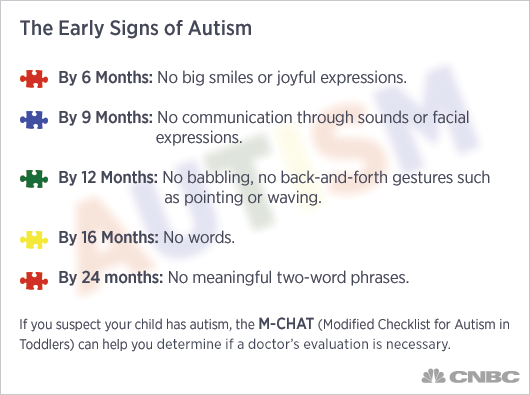Cloud Database for Autism Research
Over the past 10 years, no disorder has become so familiar to Americans, yet remained so mysterious, as autism.
Now affecting 1 in every 68 children born in the United States—up from 1 in 166 a decade ago—the condition has so far resisted nearly all efforts to cure it, curb it or even precisely define it. As a result, speculation and controversy surrounding the disease has mounted, leaving parents unsure what to believe and doctors frustrated with a lack of options.
But an unusual partnership between science, business and philanthropy may soon provide some answers. Autism Speaks, Google and geneticist Dr. Stephen Scherer have devised an ambitious plan to upload the complete genomes of 10,000 autistic patients and their families to a cloud database that will be searchable, sortable and shareable with researchers around the world. The plan, known as the Autism Speaks Ten Thousands Genome Program—or AUT10K—aims to harness the combined power of big data, crowdsourcing and genetic know-how to isolate the causes of autism and find new genetic targets for treatment.
If successful, the $50 million project could not only help doctors understand and treat autism but change the way illnesses are tackled in the 21st century.
Despite the best efforts of world-class scientists, the research on autism so far has only hinted at its roots and possible cures, said Bob Wright, co-founder of Autism Speaks. “We have raised money for the National Institutes of Health for the better part of 10 years, and they have already spent about $2 billion of it, and we still don’t have any breakdown of autism,” he said, referring to NIH. “They’re sort of nibbling outside the palace, and they can’t get in.”
“I think that this will open up a whole world of autism research,” he said. “Hopefully, we’re going to save 25 years of research in a matter of 18 to 24 months.”
Already the project is paying dividends. Later this year, Dr. Scherer will be publishing a paper based on an analysis of the first few thousand genomes to be uploaded that shows, as expected, that autism consists of more than a single condition.
Unlocking the mysteries of autism
“We have new, unpublished data that shows autism is really a collection of different disorders,” said Dr. Scherer, director of the Centre for Applied Genomics at Toronto’s Hospital for Sick Children. “This is so much the case that even in families where siblings have autism, they often have different forms of the condition and therefore need to be treated in a manner specific to their sub-type.”
This is big news for people struggling with autism, which has the unfortunate distinction of being a spectrum disorder—meaning it is characterized by a range of symptoms that may or may not stem from a singular cause.
“A spectrum disorder is the kiss of death for pharmaceutical companies,” Wright said. “They’ll say to me, ‘That’s too much work; we’re not going to tackle that.'” While this first paper may not be enough to guide the production of new treatments, it is, by any estimation, a major step forward.
Scientists have long believed that studying genes is the key to understanding disorders like autism, Down’s Syndrome and Alzheimer’s. By seeing which gene mutations are shared by people with a certain condition, researchers can isolate the causes of the disease and design drugs to treat it.
But that is easier said than done. The complete human genome contains close to 25,000 genes and takes up about 100 gigabytes of storage—the equivalent of 10 high-definition movies—when uploaded to a computer. Storing, much less analyzing and sharing, all that information is far beyond the capacity of most universities and research institutions.
Enter Google and its seemingly limitless computing capacity. About a year and a half ago, David Glazer, a Google engineering director in search for a new challenge, formed a team within the company to find life-science projects that could benefit from using its cloud platform, which was designed to store and analyze massive data sets. Autism Speaks, which had already been collecting genomes from patients and their families for 15 years, seemed the perfect fit.
“Part of Google’s business is to make our cloud platform useful and available to anyone who has hard, scalable information and data problems to solve,” Glazer said. But “until fairly recently, a biologist didn’t need a tool more powerful than Excel to work with all the data that they were able to gather. That’s changed, particularly with the advent of genomics and genomic sequencing. “This is a tremendous opportunity to really put our platform to use,” he added, “and, of course, being a great customer for our platform.”
That the lead researcher for Google’s first life-science client should be Dr. Scherer makes some historical sense. His signature work greatly contributed to the massive increase in data now produced by many geneticists.
In 2004, Dr. Scherer discovered a major form of genetic variation that researchers had previously overlooked. For decades, scientists had believed that all people were born with two pairs of every gene—one from their father and one from their mother. But using a new form of high-resolution scanning technology that allowed him to examine DNA more closely than ever before, Scherer and his colleagues found that people can have three copies of a gene, or one, or even none at all. Sometimes these copy number variants, as they are known, make no difference to a person’s development. Other times they lead to serious developmental conditions, such as autism.
“Some genes are fine in only one copy, and some are fine in zero copies, believe it or not,” he said. “But there are a set of genes that if you only have one copy, or three copies, anything away from the typical two, it causes developmental problems. And that’s what we’ve seen in autism.”
Large-scale genome sequencing
Dr. Scherer’s research—for which he was named a possible recipient of the 2014 Nobel Prize in Medicine—”opened up a new area of inquiry” in autism research, said Dr. Lonnie Zwaigenbaum, a pediatrician and autism researcher at University of Alberta. “It’s really because of that work that’s laid the groundwork for the advances that comprise the autism 10K project,” which he said had “tremendous potential to accelerate progress.”
An Ontario native, father of two and avid hockey fan, Scherer talks about AUT10K as a dream come true for a scientist used to working—and sometimes straining—within the bounds of conventional research.
“As a grad student 20 years ago, I used to dream about this technology,” he said. “We did this poor man’s science for so long, looking at little snippets, snapshots of the genome trying to figure out what it meant. We’re doing now what I call the perfect genetic experiment.”
Autism Speaks is not the only group pursuing a cure for a disease through large-scale genome sequencing. Earlier this year, the NIH awarded a $12.6 million grant to five American universities, including the Boston University School of Medicine, Columbia University and the University of Pennsylvania, to analyze whole genome sequences of Alzheimer’s patients. In 2011, the Mayo Clinic announced an effort to sequence the genomes of thousands of its patients; it later selected Complete Genomic to do the actual sequencing.
But they do think they can be the first to show large-scale results. “We’re working fast, nimble,” Scherer said. “We’re following the Google model, so I think we’ll be first.”
Scherer and Autism Speaks hope to have all the genomes uploaded to Google’s cloud database by the end of 2015. Meanwhile, Google is at work on interfaces that will allow both researchers and families to search and analyze the data.
If all goes to plan, said Wright, who co-founded Autism Speaks after his grandson was diagnosed with autism, the treatment outlook for autistic patients will look very different two years from today.
“We’re going to have a lot of interest on the part of pharmaceutical companies and treatment organizations” once they have genetic targets and a breakdown of the disease, he said. “So to me this is heaven. This is heaven.”
—By Douglas Quenqua, special to CNBC.com
To see the original article on cnbc.com click here.

















